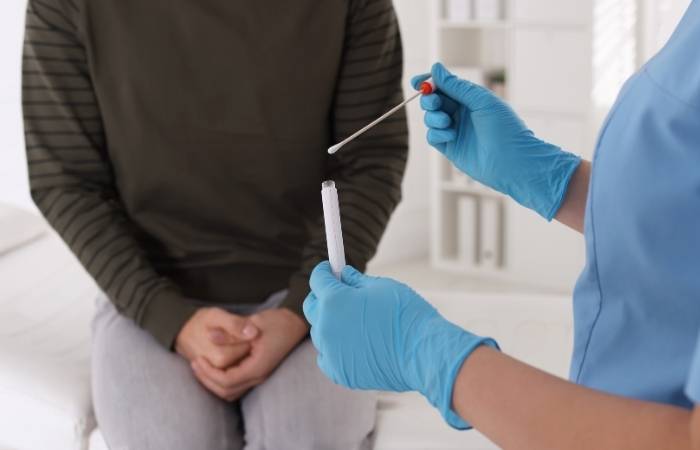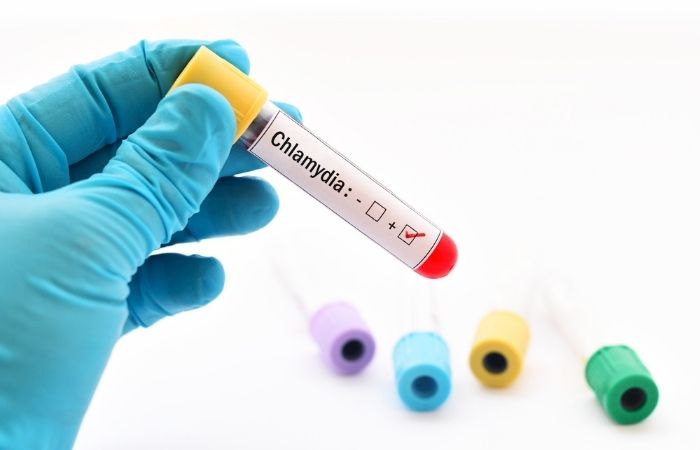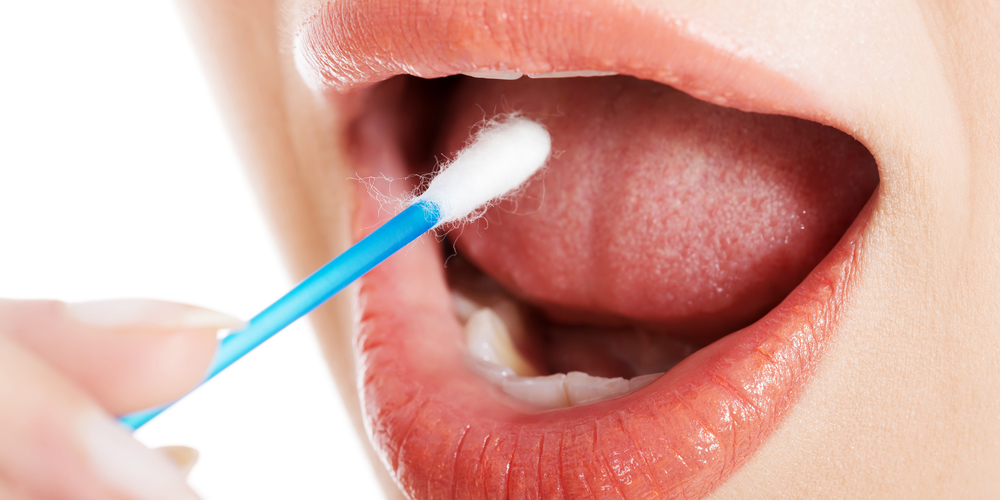The Future of STD Testing: How At-Home Kits Are Changing the Game
Quick Answer
Yes, STD testing can involve urine, blood, or swabs, depending on what you're testing for. Some infections (like Chlamydia or Gonorrhea) are usually caught with urine or swabs, while others (like HIV or Syphilis) require blood tests. Not every test needs a swab “down there”, and at-home kits can be just as accurate.
Will They Swab There?
STD testing is one of the most misunderstood rituals in modern healthcare. Not because it's complicated, but because we rarely talk about what actually happens during the process. Most people don’t find out until they’re already half-undressed on an exam table, or watching a YouTube video about someone else's experience and quietly spiraling.
And what we don’t understand, we tend to fear. So let’s clear it up: getting tested for STDs is a routine part of being a sexually active adult. It’s not a punishment or a confession. It’s a check-in, like going to the dentist or getting your cholesterol checked, just with a little more emotional baggage and a few more bodily fluids involved.
Depending on your anatomy, symptoms, and sexual practices, testing might involve peeing in a cup, getting your blood drawn, or using a swab in areas like your throat, vagina, rectum, or urethra. Some tests can be self-administered. Others are done by professionals. But none of it is done to shame or embarrass you, it’s done to protect your health and the health of your partners.
And despite what your anxiety might be whispering, no one at the clinic is judging your choices. They’re not tallying your partners or reading your mind. They’re there to help, not humiliate.

People are also looking for: Can I get tested for HIV at home?
Key Benefits of Getting Tested
The obvious benefit is, of course, knowing whether or not you have an infection. But there’s more at stake than test results. For many people, getting tested is a powerful emotional reset. It offers peace of mind, ends the guessing game, and gives you real information to make real decisions.
Testing also opens the door to early treatment. Many STDs, like Chlamydia, Gonorrhea, and Syphilis, are completely curable when caught early. Even chronic infections like Herpes or HIV are highly manageable with modern medication. But the longer they go undetected, the higher the risk for complications and transmission.
There’s also the bigger picture to consider. When you get tested, you're not just protecting yourself. You're protecting your current partner, your future partners, and your entire community. It’s one of the most tangible ways to care for others in your orbit.
And yes, for the record, getting that “all clear” text is one of the best feelings in the world. Like finally exhaling after holding your breath for weeks.
Challenges or Risks (And Why They’re Manageable)
The fear around STD testing usually has less to do with the tests themselves and more to do with what they represent. Being seen at a clinic. Admitting to risk. Saying the words “I had unprotected sex.” The experience taps into a deep cultural shame that tells us our sexuality is something to hide.
But here’s the truth: clinicians are not scandalized by your sex life. They don’t flinch at anal swabs. They aren’t fazed by same-sex partners, casual encounters, or kink. If anything, they’re relieved when someone comes in for testing without needing to be dragged or begged. And if you're still not ready for face-to-face vulnerability, at-home testing offers a powerful alternative. Modern kits are discreet, clinically accurate, and easy to use from your bathroom counter, no eye contact required.
The physical discomfort involved in testing is usually minimal. A blood draw might pinch. A throat swab may trigger your gag reflex. A vaginal or rectal swab could feel weird, but rarely painful. In most cases, the worst part is the anticipation, not the procedure itself.
And if you cry in the exam room? That’s okay too. Providers are trained to handle that. You're not the first, and you won’t be the last.
Order Now $129.00 $343.00 Check Your STD Status in Minutes
Test at Home with Remedium
7-in-1 STD Test Kit




For all 7 tests
Solutions and Recommendations
Let’s walk through the actual process of getting tested, minus the mystery. Most clinics start with a few simple questions about your symptoms, sexual history, and body parts in use. Not to pry, but to make sure the right tests are offered for the right exposures.
If you’ve had oral sex, they might recommend a throat swab. If you’ve had anal sex, a rectal swab could be added. For those with a vagina, a clinician may use a speculum or offer you the option to swab yourself, something many patients prefer. For penises, a urine sample is often all that’s needed for Chlamydia and Gonorrhea.
Blood draws are standard for Syphilis, HIV, and Hepatitis testing. These can be done via a quick finger prick or a vein draw, depending on the test. You’ll rarely need more than a few drops, and the whole thing is over in seconds.
At-home kits follow a similar structure. Depending on what you’re testing for, you may be asked to pee in a small collection vial, prick your finger for a blood spot, or use a swab in one or more locations. Kits come with detailed instructions and pre-paid return envelopes. Some even include video support if you get nervous.
Results are usually sent via email or secure portal. Depending on the kit or clinic, you might hear back in 1–10 days. Faster than your last situationship reply.
Statistical Insights and Data
STD testing isn’t just recommended, it’s needed. The numbers tell a story that’s both sobering and motivating. According to the CDC, 1 in 5 people in the U.S. had an STI at any given time in 2018. That’s over 68 million current infections, and many people don’t even know they’re carrying one.
Why? Because most STDs have no symptoms. Up to 70% of Chlamydia cases, for instance, are totally silent. Gonorrhea? Same deal, especially in the throat or rectum. That means waiting until something “feels wrong” isn’t a reliable strategy.
Testing is how we find the infections we can’t see. It’s how we break the chain of silent spread. And it’s how we stop normal sexual activity from turning into a public health problem.
It’s also more accessible than ever. At-home STD test kits are now available for everything from Herpes to HIV, and they’re being used by millions every year. The market for mail-in sexual health tests has grown over 30% annually since 2020, and it's not slowing down.

People are also looking for: Do I really need dental dams?
Expert Opinions and Case Studies
“Most people are shocked by how fast and painless it actually is,” says Jordan, a nurse practitioner at a New York City LGBTQ+ clinic. “The buildup in their head is always worse than the swab.”
She recalls one patient who nearly walked out when he saw the collection tray. He assumed the urethral swab meant a long stick shoved down his penis. In reality? “We asked for a urine sample. That’s it.”
Tyra, 21, had been avoiding testing for over a year after a hookup ended with a rash and a spiral.
“I thought they’d look at me like I was dirty,” she said. “Instead, they told me it was probably eczema, but they still did the full panel just to be safe. I was negative across the board. I cried anyway. I’d been carrying that shame for months.”
These stories aren’t rare, they’re the norm. People walk into clinics expecting punishment and walk out with answers, clarity, and often, relief.
Historical Context
STD testing hasn’t always been so patient-friendly. Go back a few decades, and you’ll find a world where the process was deeply tied to moral judgment, especially for women, queer folks, and sex workers. Early tests for Syphilis in the 1940s involved spinal taps. During the 1980s HIV crisis, testing came with shame, secrecy, and in many cases, discrimination.
Even well into the 2000s, rectal and throat testing for Gonorrhea and Chlamydia wasn’t routinely offered, despite clear evidence those areas could be infected. It was up to patients to ask, which most didn’t know to do.
Things are different now. The rise of inclusive sexual health clinics, the normalization of telehealth, and the creation of user-friendly home kits have revolutionized the experience. Testing is faster. More inclusive. Less invasive. And finally, less taboo.
Check Your STD Status in Minutes
Test at Home with Remedium3-in-1 STD Test Kit

 For Men & Women
For Men & Women Results in Minutes
Results in Minutes No Lab Needed
No Lab Needed Private & Discreet
Private & DiscreetOrder Now $69.00 $147.00
For all 3 tests
Future Trends
Looking ahead, the evolution of STD testing is laser-focused on three things: privacy, accessibility, and speed. More clinics are training providers in trauma-informed care. More apps are offering same-day booking and discreet result delivery. More communities are building queer-friendly, judgment-free testing spaces.
On the tech side, research is expanding into oral-fluid testing for STIs beyond HIV, and scientists are exploring self-diagnostic tools that could give results within minutes, no lab needed. AI-driven sexual health bots already exist, and may soon be able to guide users to the right tests based on real-time symptom input.
This is where sexual healthcare is going: personalized, low-touch, and built on consent.
Practical Applications
STD testing shouldn’t be something we only do when we’re scared. It should be a normal part of our sexual routines, like grabbing condoms or asking about allergies. But how often should you test? That depends.
If you're sexually active with multiple partners, testing every 3–6 months is a solid rhythm. Monogamous? Once a year is the standard, unless symptoms pop up or you’ve had a recent partner change. If you're in a relationship but non-monogamous or poly, regular testing is part of what makes those dynamics work safely. And if you’re someone who’s just had a one-night stand and felt weird after? That’s reason enough to test too.
Timing also matters. Most STDs don’t show up instantly. There's a window period, anywhere from a few days to a few months, before infections can be reliably detected. That's why follow-up testing is sometimes needed, especially for HIV or Syphilis.
Your best tool? A calendar reminder and a little less shame. If we treated sexual health checkups like dental cleanings, the world would be a much healthier, and much less anxious, place.

People are also looking for: Can you get an STD even if you used a condom?
Common Misconceptions
Let’s clear out a few mental cobwebs. First, no, getting tested isn’t an admission that you’ve done something “bad.” It’s an act of care. You brush your teeth because you like having them. You test because you want to keep yourself and others safe.
Second, not all STDs show symptoms. In fact, the vast majority don’t. If you’re waiting for burning, itching, or oozing to decide whether to test, you’re probably already late.
Third, you can’t always tell someone’s status by looking at them. Clean-cut guys can have Herpes. Girls who “seem safe” can carry Chlamydia. Your hookup’s vibe doesn’t determine your risk.
And finally, yes, at-home test kits are legit. They’re backed by lab processing, just like in-clinic testing. The only difference is that you’re the one collecting the sample. For many people, that’s the ideal balance of privacy and precision.
Personal Stories and Testimonials
“I used to dread testing. I thought it meant I was dirty or promiscuous,” said Mel, 29, who now gets tested every 6 months as part of her polyamorous relationship agreements. “But now it feels like brushing my teeth, boring, necessary, and kind of satisfying.”
Danny, 19, got his first STD test after his girlfriend said something didn’t feel right. “I was scared out of my mind,” he admitted. “But the nurse talked me through it, and the test itself was nothing. I peed in a cup and was done in two minutes.”
These stories are your reminder that fear is normal, but it doesn’t have to win. Testing is power. Information is power. You’re not just surviving your sex life. You’re mastering it.
Order Now $75.00 $98.00 Check Your STD Status in Minutes
Test at Home with Remedium
Genital & Oral Herpes Test Kit




For all 2 tests
FAQs
1. Can they test for all STDs at once?
Yes, full panel tests cover multiple infections in one go. At-home or clinic panels often include Chlamydia, Gonorrhea, Syphilis, HIV, Herpes, and Hepatitis.
2. Do STD tests hurt?
Most don’t. A blood draw might sting. A swab may be awkward. But pain? Rare. It’s way milder than people expect.
3. Can you test during your period?
Yes. Your period doesn’t affect most tests. If you’re using a vaginal swab, the provider may adjust timing, but blood and urine tests are unaffected.
4. Will they swab my penis?
Usually not. Chlamydia and Gonorrhea are now tested through urine, not urethral swabs, in most cases. Swabs are used for throat or rectum if needed.
5. Can I do an STD test at home?
Absolutely. At-home kits are accurate and confidential. Some even offer follow-up consultations if something comes back positive.
6. How soon after sex should I test?
It depends on the STD. Some show up within days, others take weeks. For HIV, testing at 1 month and again at 3 months is best practice.
7. Do all STDs show symptoms?
Not at all. Many infections, especially Chlamydia, HPV, and HIV, can stay silent for months or years.
Can men get tested without symptoms?
Yes, and they should. Lack of symptoms doesn’t mean you’re in the clear. Routine testing is just as important for men.
Can I get an STD from oral sex?
Yes. Infections like Gonorrhea, Syphilis, Herpes, and HPV can all be transmitted through oral contact.
What if I cry or panic during testing?
Then you’re human. Providers are used to this and trained to support you. You won’t be the first or last person to feel emotional about it.
Be Responsible!
You made it through the awkward questions, the myths, the realities, and the rectal swabs. So what now? Maybe it’s time to test. Maybe it’s time to talk to a partner. Or maybe you just needed to hear that this isn’t the giant, shame-drenched ordeal you thought it was.
STD testing is part of life. Not the dirty part. Not the reckless part. The responsible, caring, I-give-a-damn part. And when you’re ready, you’ve got options. From full-panel kits to fast clinic visits, there’s no one right way to do this, just your way.
Take control of your sexual health today with an at-home test kit
Sources
1. How to Get Free At-Home HIV Tests Every 3 Months Until 2027 – SELF
2. At-Home HIV Tests: Benefits, Accuracy, and More – Verywell Health
3. Safe Sex in the Age of Self-Testing – Vox
4. Keir Starmer Takes Public HIV Test to Tackle Stigma – The Guardian
5. The Evolution of BioSure’s At-Home HIV Test – Wired
6. WHO Offers $1 HIV Self-Tests for Low-Income Countries – WHO










